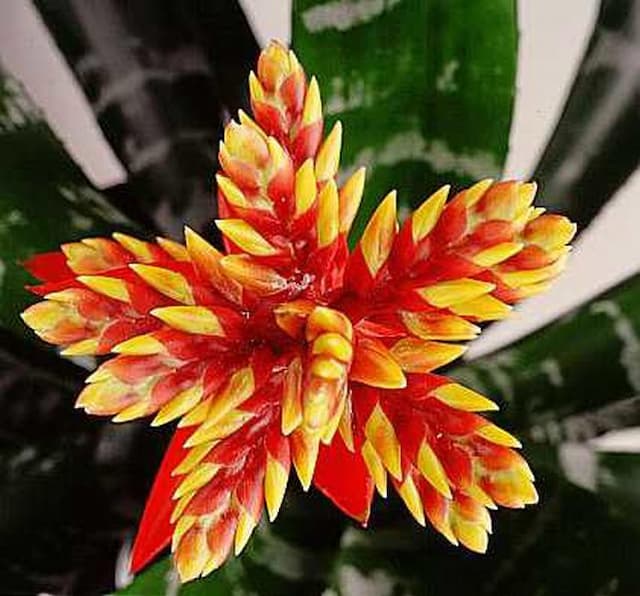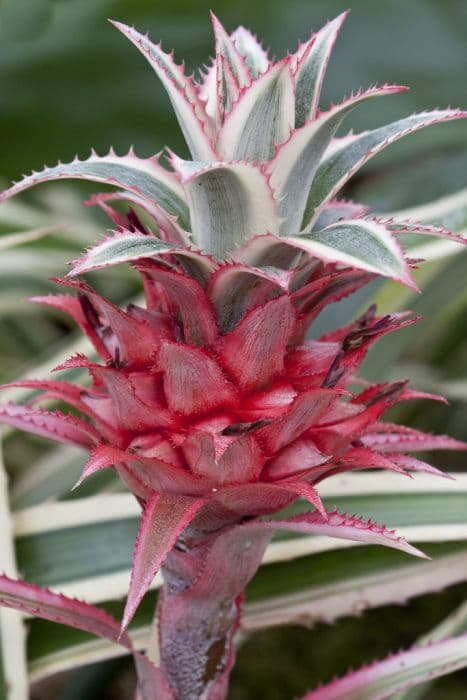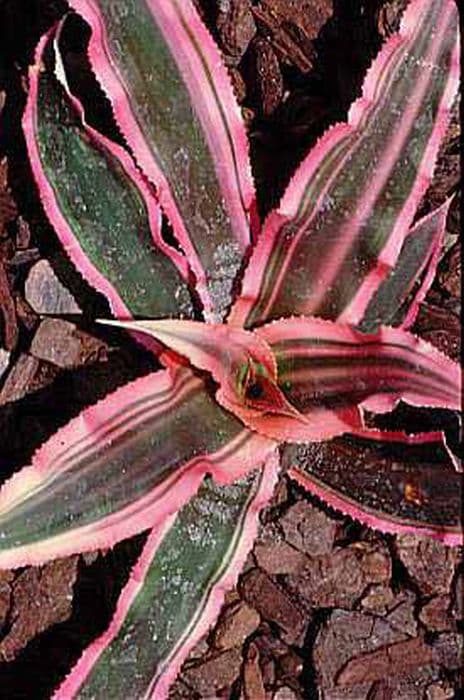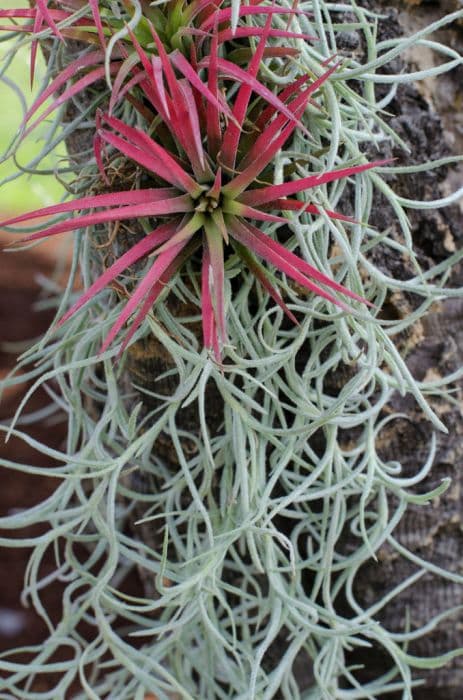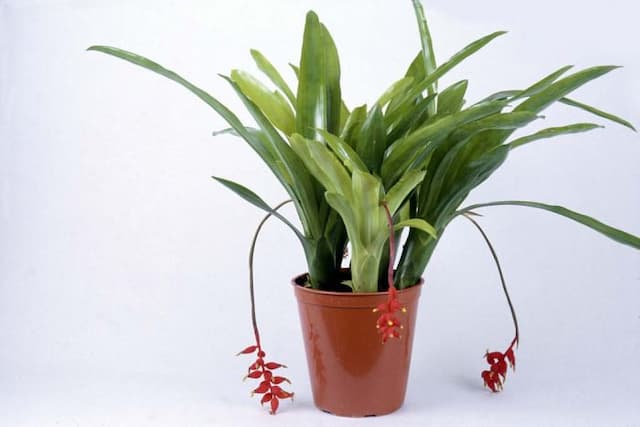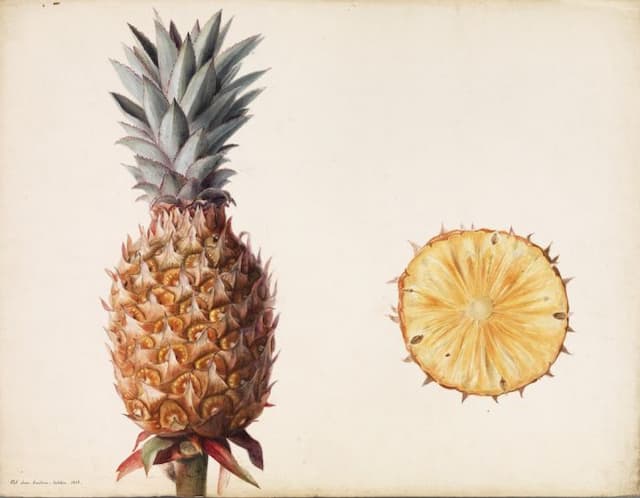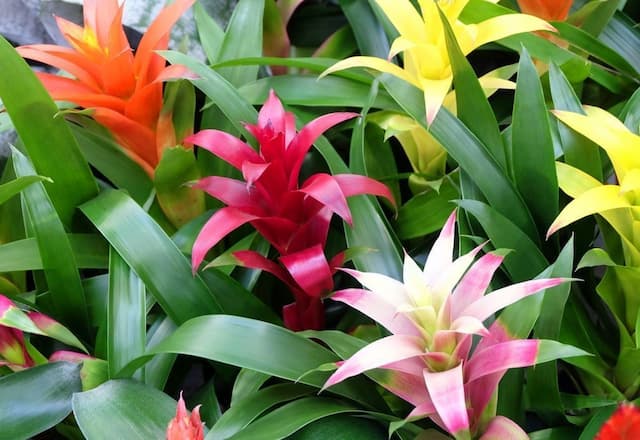Chilean Bromeliad Ochagavia carnea

ABOUT
Ochagavia carnea, commonly known as the Chilean Bromeliad, is a striking plant with rosettes of sturdy, green leaves. The leaves, which have a slightly spiky appearance, can vary in color from a deep green to having reddish-pink tips, depending on the variety and growing conditions. The foliage tends to be glossy and may have small teeth along the edges, giving it a somewhat serrated look. The Chilean Bromeliad has a compact and symmetrical shape, with the leaves emerging from a central point, creating an attractive visual pattern reminiscent of a star or a pinwheel. The plant produces a remarkable flower when in bloom. The blossom emerges from the center of the rosette, typically displaying an eye-catching hue of pink. The floral structure is a cluster, which adds a splash of vibrant color and contrast against the thick and lush leaves. The overall appearance of the Chilean Bromeliad is both tough and beautiful, with its leaves creating a dense foliage that is both appealing to the eye and pleasantly architectural in form. Despite its robust look, the plant exudes a delicate charm when in flower, making it a favored choice for garden enthusiasts and those appreciating ornamental plants.
About this plant
 Names
NamesFamily
Bromeliaceae
Synonyms
Ochagavia Lily, Pink Bromeliad, Clavel del Aire
Common names
Rhodostachys carnea, Greigia carnea.
 Toxicity
ToxicityTo humans
Ochagavia carnea, commonly known as the Chilean bromeliad, does not have a well-documented profile of toxicity to humans. Information on its potential poisonous effects if ingested is not widely available. As with any plant, if ingestion occurs and adverse symptoms are noted, medical attention should be sought.
To pets
Similar to its toxicity to humans, there is no widely available information regarding the toxicity of Ochagavia carnea, or the Chilean bromeliad, to pets. It remains unknown if ingestion of any part of this plant may cause poisoning in pets. In the absence of specific toxicity data, it is generally prudent to prevent pets from ingesting plants. If a pet does ingest any part of the plant and shows signs of distress, a veterinarian should be consulted.
 Characteristics
CharacteristicsLife cycle
Perennials
Foliage type
Evergreen
Color of leaves
Green
Flower color
Pink
Height
1 foot (0.3 meters)
Spread
2 feet (0.6 meters)
Plant type
Succulent
Hardiness zones
9
Native area
Chile
Benefits
 General Benefits
General Benefits- Ornamental Appeal: Ochagavia carnea, commonly known as the Chilean Bromeliad, adds aesthetic value to gardens and homes with its vibrant pink flowers and rosette-forming succulent leaves.
- Low Maintenance: Being a hardy plant, it requires minimal care, making it suitable for busy individuals or those new to gardening.
- Drought Tolerant: It is adapted to survive with little water, making it an ideal plant for xeriscaping and arid climate gardens.
- Adaptability: This plant is versatile and can grow in a variety of soil types as long as they provide good drainage.
- Compact Size: Due to its small size, it is suitable for container gardening, terrariums, and as a houseplant for small spaces.
- Propagation Ease: Ochagavia carnea can be easily propagated from offsets, making it simple to expand your collection or share with friends.
- Habitat Support: It can provide habitat and food for various insects, contributing to the local ecosystem's biodiversity.
 Medical Properties
Medical PropertiesThis plant is not used for medical purposes.
 Air-purifying Qualities
Air-purifying QualitiesThis plant is not specifically known for air purifying qualities.
 Other Uses
Other Uses- Ochagavia carnea, commonly known as "Chilean bromeliad", can be used in teaching and educational environments to illustrate plant adaptations to arid climates.
- The striking pink flowers of the Chilean bromeliad provide an excellent opportunity for photographers and artists to capture and study plant structure and aesthetics.
- This plant can be used in floristry as a long-lasting component of exotic and tropical flower arrangements.
- Due to its compact size and ease of care, the Chilean bromeliad is suitable for space-limited gardening, including terrariums and dish gardens.
- The Chilean bromeliad can be incorporated into multicultural studies to explore indigenous uses of plants in Chilean culture and history.
- Hobbyists who specialize in collecting unusual plants may prize Ochagavia carnea as an addition to their bromeliad collections.
- Its resistance to drought makes the Chilean bromeliad a candidate for studying sustainable landscaping in xeriscaped gardens.
- The unique growth pattern and rosette formation of the Chilean bromeliad's leaves can be used to inspire design elements in fields such as architecture or fashion.
- This plant may serve as an educational tool in botany courses to discuss the topic of plant survival in rocky soil environments where other plants may not thrive.
- Chilean bromeliad is useful in butterfly gardens or pollinator-friendly gardens to attract and support local wildlife, particularly hummingbirds.
Interesting Facts
 Feng Shui
Feng ShuiThe Ochagavia carnea, commonly known as the Chilean Bromeliad, is not used in Feng Shui practice.
 Zodiac Sign Compitability
Zodiac Sign CompitabilityThe Chilean Bromeliad is not used in astrology practice.
 Plant Symbolism
Plant Symbolism- Resilience: Ochagavia carnea, also known as Pineapple Mountain, exemplifies resilience with its ability to thrive in rocky soils and withstand the harsh conditions of its native habitat.
- Independence: The Pineapple Mountain plant's self-sufficient growth habit symbolizes the value of independence and the ability to sustain oneself without relying heavily on others.
- Survival: This plant's capacity to survive in challenging environments makes it a symbol of survival, highlighting the strength and willpower needed to overcome obstacles and hardships.
- Adaptability: The adaptability of Pineapple Mountain showcases the importance of being flexible and open to change, adapting successfully to various conditions and changes in life.
 Water
WaterFor the Chilean Bromeliad, it is important to water when the top inch of the soil feels dry to the touch, roughly every 7 to 10 days, depending on the humidity and temperature conditions of your home. Provide enough water to soak the soil through to the drainage holes which may amount up to 8-16 ounces each time, but make sure not to let the plant sit in water as this can lead to root rot. During the winter months, watering frequency should be reduced as the plant enters a period of slower growth.
 Light
LightThe Chilean Bromeliad prefers bright, indirect light to maintain its vibrant foliage and overall health. The best spot for this plant would be near an east or south-facing window where it can receive plenty of light without the harsh direct sun that could scorch its leaves. Avoid deep shade locations to prevent the leaves from losing their color and the plant from becoming leggy.
 Temperature
TemperatureThe Chilean Bromeliad thrives in temperatures between 60 and 75 degrees Fahrenheit but can tolerate a range from 50 to 80 degrees. Protect it from temperatures below 50 degrees, as cold drafts and frost can damage the plant. To ensure optimal growth, maintain steady indoor temperatures without sudden fluctuations.
 Pruning
PruningPrune the Chilean Bromeliad to remove any dead or damaged leaves and to maintain its shape, using sterilized pruning shears. Cut close to the base of the leaf but be careful not to harm the healthy parts of the plant. Pruning is best done in spring or early summer before new growth begins. Regular trimming also encourages fresh growth and can enhance the plant's overall appearance.
 Cleaning
CleaningAs needed
 Soil
SoilThe Chilean Bromeliad, commonly referred to as Ochagavia carnea, thrives in a well-draining soil mix, such as a blend of peat, pine bark, and sand, with a slightly acidic to neutral pH of 5.5 to 7.0.
 Repotting
RepottingChilean Bromeliads should be repotted every 2-3 years to refresh the soil mix and to accommodate root growth.
 Humidity & Misting
Humidity & MistingChilean Bromeliads prefer a humidity level of 60% or higher for optimal growth; however, they are adaptable and can tolerate lower humidity.
 Suitable locations
Suitable locationsIndoor
Bright indirect light, well-drain soil, and moderate watering for Chilean Bromeliad.
Outdoor
Partial sun, protect from frost, well-draining soil for Chilean Bromeliad.
Hardiness zone
9-11 USDA
 Life cycle
Life cycleOchagavia carnea, commonly known as Pink Bromeliad, begins its life as a seed that germinates in well-draining soil, typically taking refuge in the crevices of rocks or trees in its natural habitat. The seedling develops into a small rosette, gathering nutrients and water with its tightly overlapping leaves. As it matures, the Pink Bromeliad produces a central flower stalk, displaying a vibrant arrangement of pink bracts and flowers which attract pollinators. After pollination, the plant sets seed, completing its reproductive cycle. Simultaneously, the original rosette slowly dies back, but not before producing offsets, or "pups," around the base, which will grow into new individuals. This perennial plant thus ensures its propagation both through seed and vegetative reproduction, allowing the population to persist and expand.
 Propogation
PropogationPropogation time
Spring-Early Summer
Ochagavia carnea, commonly known as the Pink Pineapple Plant, is most successfully propagated through the division of offsets. Typically, the best time to propagate is in the spring or early summer when the plant's growth is most active. The process involves carefully separating the offsets, which are small clones of the parent plant that develop naturally at its base. Each offset must have a portion of the root system to ensure successful rooting. After separation, the offsets can be potted into individual containers filled with a well-draining soil mix. Water the newly potted offsets lightly to encourage root growth and acclimatization to the new environment, but be sure not to overwater. In a matter of weeks, with proper care, the offsets should establish their own root systems and begin to grow, eventually becoming independent plants that resemble the parent.
